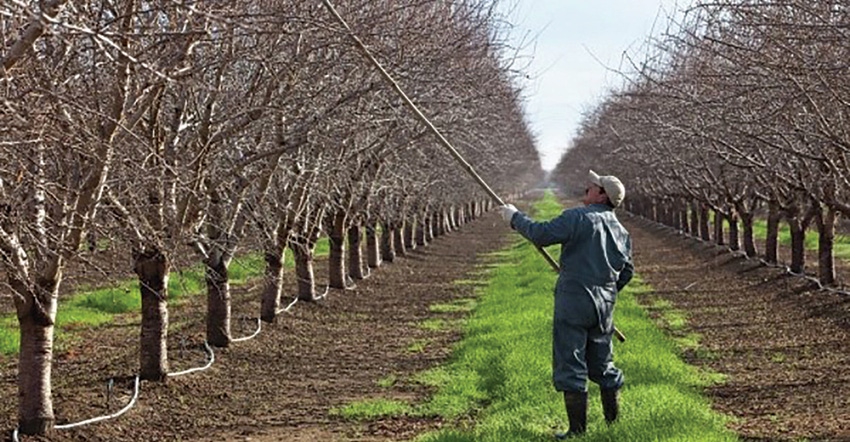
While the holiday season traditionally includes generosity to the less fortunate in the form of food and housing, that generosity doesn’t extend to California nut growers and their No. 1 pest, the navel orangeworm, that seeks out food and shelter in unharvested mummy nuts.
Experience has evolved a generic timeline to minimize NOW problems.
By mid-January, growers should have scouted their orchards in the dormant season in search of mummy nuts, picking about two dozen trees per acre. If there are more than two leftover nuts per tree, it’s sanitation time. In a compressed activity zone like southern San Joaquin Valley, even tighter scrutiny/response is recommended because the fewer mummy nuts there are in an orchard, the fewer NOW problems once the season starts.
By late January, all trees should have had a sanitation shake with the caution that during early bloom seasons when buds begin to swell earlier than usual, shaking in late January and into early February can knock off those swelling buds and take them out of the flower set category. If that concern exists, the option is for hand-poling.
Removed mummies should be swept into windrows and slowly flail mowed or disked, preferably by the end of February so the season can kick off with a sanitized orchard.
Timing is important. Years ago (1983), a University of California Cooperative Extension Farm Advisor, C. Steven Sibbett in Tulare County, wrote about Effect on yield from shaking almond trees for mummy nut removal and noted that “Tree shaking has little effect on yield, but late shaking isn’t recommended.”
It was Sibbett’s contention that “An integrated crop management system could reduce by 50-to-90 percent, the extensive losses previously caused by NOW infestations.” He added: “Yield, as measured by the number of nuts and weight of nutmeats per tree, was not reduced by dormant shaking to remove mummies. Although no loss of yield was observed during the last shaking date (end of January), we do not recommend late shaking because of the potential for bud removal and yield reduction increases as bloom approaches.”
Dealing with cost
While “the best things in life are free” is a feel-good expression, it doesn’t apply to mummy shake protective efforts. Kern County UCCE entomology advisor David Haviland has written that “the cost of dealing with the NOW pest --- what he calls 'the arch nemesis' is ‘huge’."
“On every acre of almonds or pistachios in California, growers will spend $200, $300, sometimes $400 --- on one acre --- just doing mummy removal,” he reported, adding: “The best strategy for keeping the pest in check is clearing nuts leftover after harvest.”
In Calusa/Sutter/Yuba counties, UCCE farm advisor Franz Niederholzer says the late almond harvest has wrapped up and processing reports show “good non-pareil quality with pollenizer varieties falling off a bit in site-specific instances.”
Mummy eradication starts when the leaves are off. “Much easier to see the remaining nuts after leaf loss and many growers wait for moisture to make the mummies heavier and easier to remove.”
Asked to look ahead to prospects for the 2022 season and predict what will be problematic for nut growers, Niederholzer states a familiar, “water, water, and water…availability and quality. This is the arid West and you need water to stay in business. There’s a big concern that we may not have any the way things are going.”
About the Author(s)
You May Also Like




